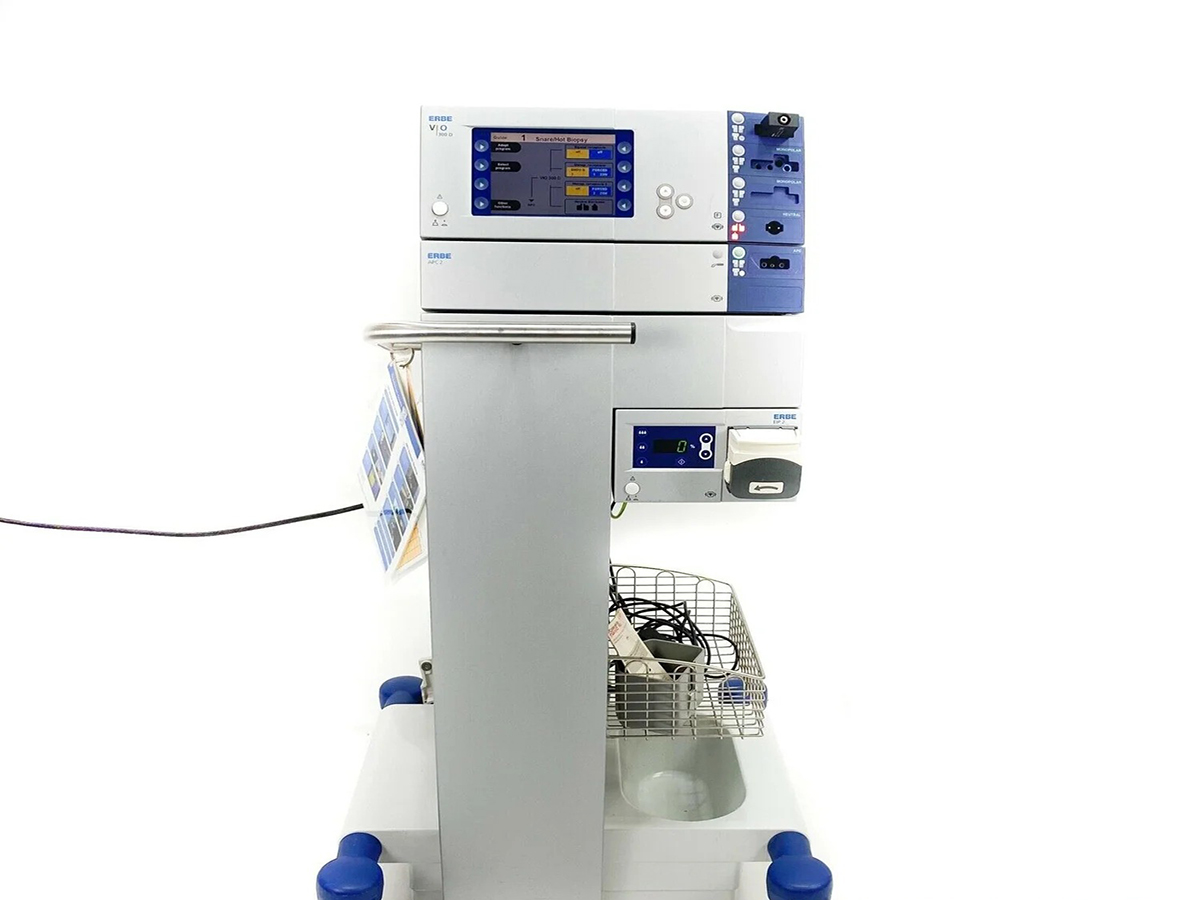Erbe VIO 300 D ARGON GAS

The Erbe VIO 300 D is a powerful electrosurgical unit that can also be paired with argon gas for Argon Plasma Coagulation (APC), similar to the VIO 200 D, but with enhanced capabilities and higher output power. The VIO 300 D is designed to deliver precise, controlled cutting and coagulation during surgical procedures, and when used with an argon plasma system, it allows for non-contact coagulation in a variety of medical applications.
Key Features of the Erbe VIO 300 D with Argon Gas (APC):
Higher Output Power: Compared to the VIO 200 D, the VIO 300 D offers more output power, which can be beneficial for procedures that require more energy or more complex tissue interaction.
Argon Plasma Coagulation (APC):
Non-Contact Coagulation: Just like the VIO 200 D, the VIO 300 D uses ionized argon gas to deliver coagulation energy without direct tissue contact. This is ideal for treating large areas of tissue or controlling diffuse bleeding.
Controlled Depth of Coagulation: The ionized argon plasma limits the depth of energy penetration, allowing for a controlled, shallow coagulation that avoids deep tissue damage. This feature is particularly useful in delicate tissues, such as mucosal surfaces or internal organs.
Uniform Coagulation: The argon gas spreads across the surface of the tissue, ensuring an even application of energy, which makes it highly effective in achieving hemostasis across a larger area of tissue.
Applications of APC with the Erbe VIO 300 D:
Gastroenterology: Used for treating gastrointestinal bleeding, esophageal varices, Barrett’s esophagus, and polyps. APC is a preferred tool for controlling bleeding from ulcers, vascular malformations, and tumors in the digestive tract.
General Surgery: APC is used in liver surgery, for hemostasis of diffuse bleeding, and for the treatment of adhesions.
Pulmonology: APC is commonly used in bronchoscopy to treat endobronchial tumors or stop bleeding in the lungs.
Urology: In procedures such as bladder tumor resections or prostate surgeries, APC can be used for coagulation without significant risk of damaging underlying structures.
Dermatology and ENT: APC is effective in treating superficial lesions and can be used for coagulation in ENT (Ear, Nose, and Throat) surgeries.
Advantages of Argon Plasma Coagulation:
Non-Contact and Minimally Invasive: By avoiding direct contact with tissue, APC reduces the risk of tissue sticking to instruments and minimizes mechanical trauma to the tissue.
Minimized Thermal Spread: APC limits the spread of heat, which is especially important for procedures where the surrounding tissues must be preserved, such as in delicate organs or mucosal surfaces.
Less Smoke and Odor: Using argon gas helps to reduce the production of smoke and the odor associated with burning tissue, which improves the surgeon’s field of view and creates a more pleasant operating environment.
Safety Mechanisms:
The VIO 300 D with APC includes safety features such as automatic regulation of the argon gas flow and real-time monitoring of tissue impedance. These features help prevent gas embolism and ensure the energy is delivered effectively and safely.
Flexibility and Versatility:
The Erbe VIO 300 D can be used with a variety of surgical instruments and accessories, making it adaptable for different surgical disciplines and procedures. The device can be programmed with specific settings for different applications, allowing for rapid setup and adjustments during surgery.
Integration with Other Systems:
The VIO 300 D integrates seamlessly with Erbe's other electrosurgical and endoscopic devices, including smoke evacuation systems and visualization tools. It can be used in conjunction with Erbe APC 2 or APC 3 systems for delivering advanced argon plasma coagulation.
Setup and Usage with Argon Gas:
To use the VIO 300 D with argon gas for APC, the system typically requires:
An argon gas supply connected to the unit.
A compatible APC probe that delivers the argon plasma to the surgical site.
Specific settings on the VIO 300 D to control the energy output, gas flow rate, and other parameters depending on the procedure being performed.
Common APC Settings:
Low Power Mode: Used for superficial treatments and areas requiring minimal thermal impact.
Higher Power Mode: Suitable for coagulating larger areas or controlling more intense bleeding.
In summary, the Erbe VIO 300 D Electrosurgical Unit paired with argon gas for Argon Plasma Coagulation (APC) provides enhanced power, precision, and versatility for surgeons across multiple medical disciplines. It is especially effective in achieving non-contact, controlled coagulation for hemostasis and tissue management during complex procedures.